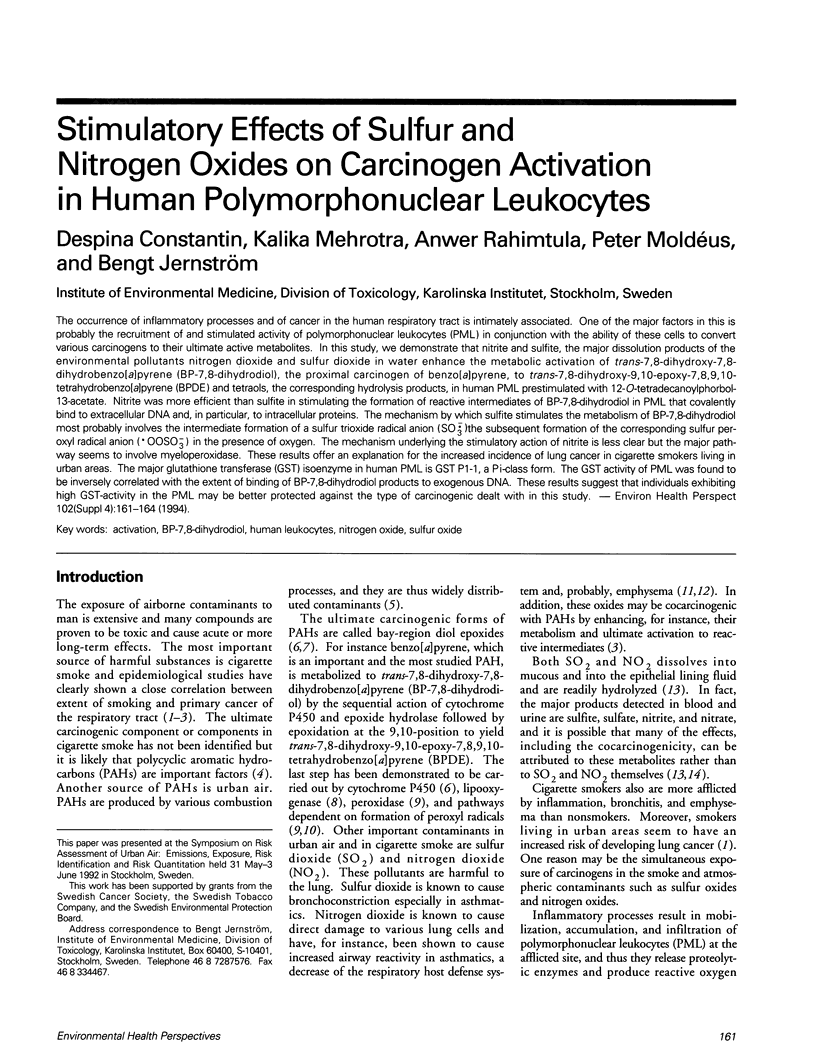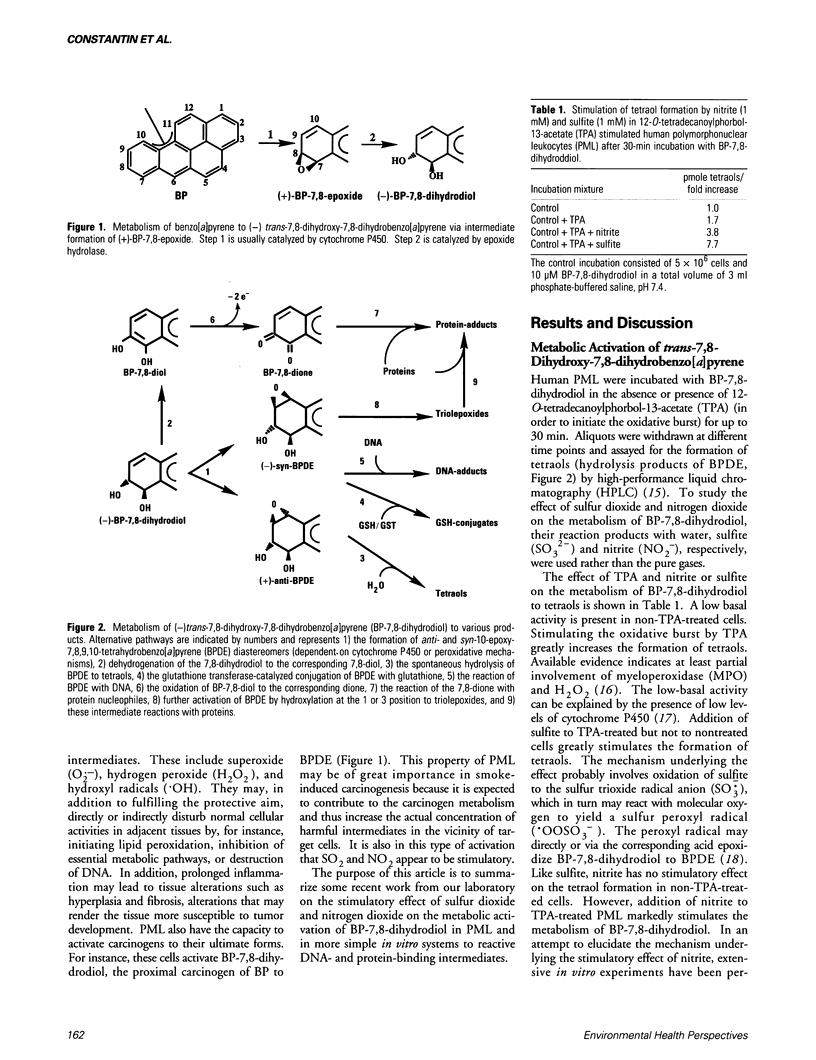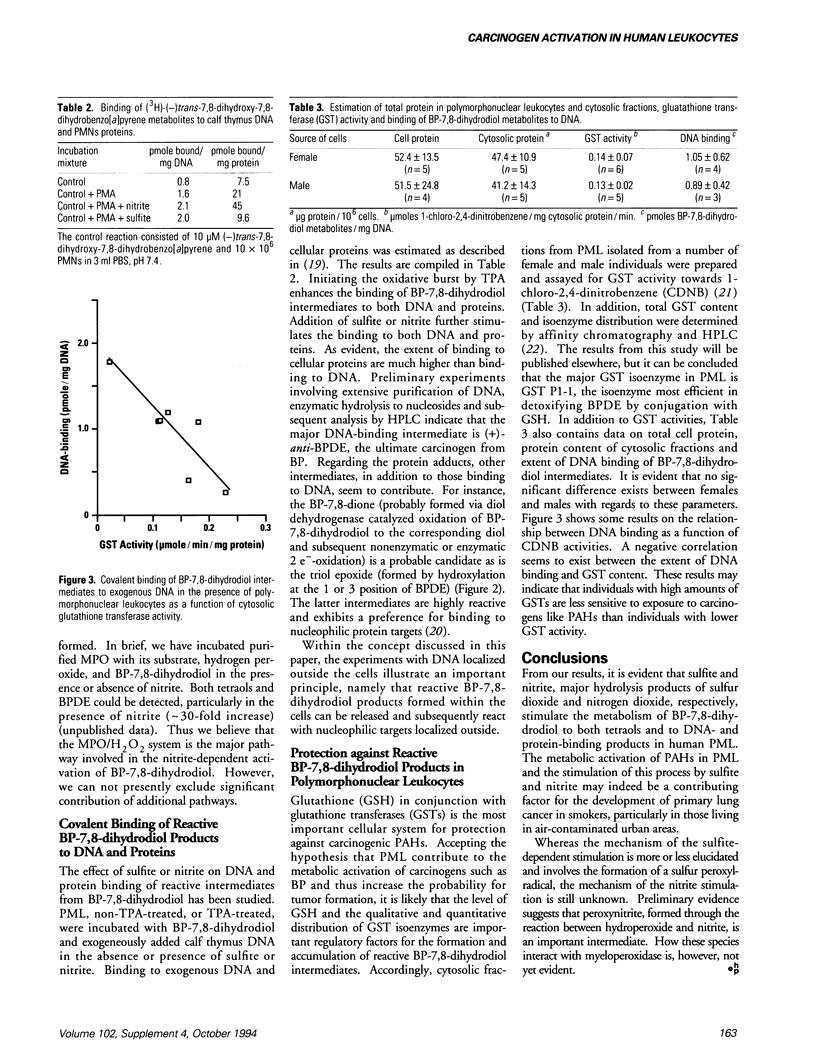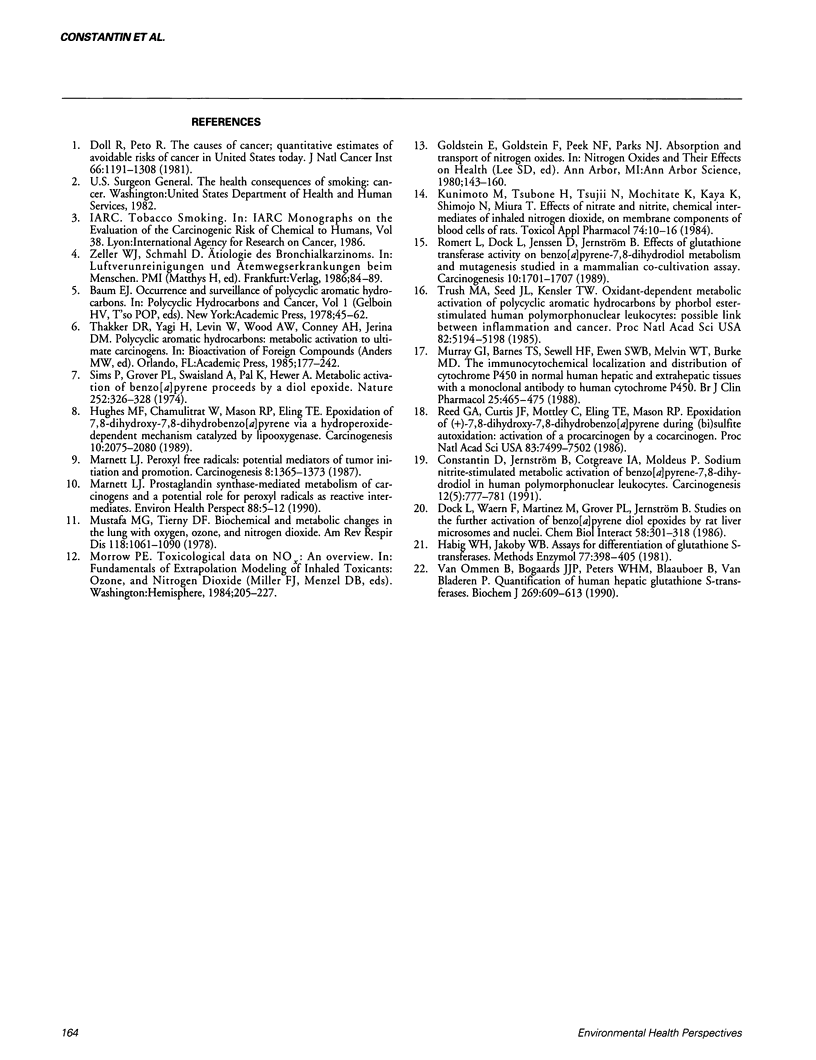Abstract
The occurrence of inflammatory processes and of cancer in the human respiratory tract is intimately associated. One of the major factors in this is probably the recruitment of and stimulated activity of polymorphonuclear leukocytes (PML) in conjunction with the ability of these cells to convert various carcinogens to their ultimate active metabolites. In this study, we demonstrate that nitrite and sulfite, the major dissolution products of the environmental pollutants nitrogen dioxide and sulfur dioxide in water enhance the metabolic activation of trans-7,8-dihydroxy-7,8-dihydrobenzo[a]pyrene (BP-7,8-dihydrodiol), the proximal carcinogen of benzo[a]pyrene, to trans-7,8-dihydroxy-9,10-epoxy-7,8,9,10-tetrahydrobenzo[a]pyrene (BPDE) and tetraols, the corresponding hydrolysis products, in human PML prestimulated with 12-O-tetradecanoylphorbol-13-acetate. Nitrite was more efficient than sulfite in stimulating the formation of reactive intermediates of BP-7,8-dihydrodiol in PML that covalently bind to extracellular DNA and, in particular, to intracellular proteins. The mechanism by which sulfite stimulates the metabolism of BP-7,8-dihydrodiol most probably involves the intermediate formation of a sulfur trioxide radical anion (SO3.-) the subsequent formation of the corresponding sulfur peroxyl radical anion (.OOSO3-) in the presence of oxygen. The mechanism underlying the stimulatory action of nitrite is less clear but the major pathway seems to involve myeloperoxidase. These results offer an explanation for the increased incidence of lung cancer in cigarette smokers living in urban areas. The major glutathione transferase (GST) isoenzyme in human PML is GST P1-1, a Pi-class form. The GST activity of PML was found to be inversely correlated with the extent of binding of BP-7,8-dihydrodiol products to exogenous DNA. These results suggest that individuals exhibiting high GST-activity in the PML may be better protected against the type of carcinogenic dealt with in this study.
Full text
PDF



Selected References
These references are in PubMed. This may not be the complete list of references from this article.
- Constantin D., Jernström B., Cotgreave I. A., Moldeus P. Sodium nitrite-stimulated metabolic activation of benzo[a]pyrene 7,8-dihydrodiol in human polymorphonuclear leukocytes. Carcinogenesis. 1991 May;12(5):777–781. doi: 10.1093/carcin/12.5.777. [DOI] [PubMed] [Google Scholar]
- Dock L., Waern F., Martinez M., Grover P. L., Jernstrom B. Studies on the further activation of benzo[a]pyrene diol epoxides by rat liver microsomes and nuclei. Chem Biol Interact. 1986 Jun;58(3):301–318. doi: 10.1016/s0009-2797(86)80105-3. [DOI] [PubMed] [Google Scholar]
- Doll R., Peto R. The causes of cancer: quantitative estimates of avoidable risks of cancer in the United States today. J Natl Cancer Inst. 1981 Jun;66(6):1191–1308. [PubMed] [Google Scholar]
- Habig W. H., Jakoby W. B. Assays for differentiation of glutathione S-transferases. Methods Enzymol. 1981;77:398–405. doi: 10.1016/s0076-6879(81)77053-8. [DOI] [PubMed] [Google Scholar]
- Huang M. T., Chang R. L., Wood A. W., Newmark H. L., Sayer J. M., Yagi H., Jerina D. M., Conney A. H. Inhibition of the mutagenicity of bay-region diol-epoxides of polycyclic aromatic hydrocarbons by tannic acid, hydroxylated anthraquinones and hydroxylated cinnamic acid derivatives. Carcinogenesis. 1985 Feb;6(2):237–242. doi: 10.1093/carcin/6.2.237. [DOI] [PubMed] [Google Scholar]
- Hughes M. F., Chamulitrat W., Mason R. P., Eling T. E. Epoxidation of 7,8-dihydroxy-7,8-dihydrobenzo[a]pyrene via a hydroperoxide-dependent mechanism catalyzed by lipoxygenases. Carcinogenesis. 1989 Nov;10(11):2075–2080. doi: 10.1093/carcin/10.11.2075. [DOI] [PubMed] [Google Scholar]
- Kunimoto M., Tsubone H., Tsujii N., Mochitate K., Kaya K., Shimojo N., Miura T. Effects of nitrate and nitrite, chemical intermediates of inhaled nitrogen dioxide, on membrane components of red blood cells of rats. Toxicol Appl Pharmacol. 1984 Jun 15;74(1):10–16. doi: 10.1016/0041-008x(84)90264-3. [DOI] [PubMed] [Google Scholar]
- Marnett L. J. Peroxyl free radicals: potential mediators of tumor initiation and promotion. Carcinogenesis. 1987 Oct;8(10):1365–1373. doi: 10.1093/carcin/8.10.1365. [DOI] [PubMed] [Google Scholar]
- Marnett L. J. Prostaglandin synthase-mediated metabolism of carcinogens and a potential role for peroxyl radicals as reactive intermediates. Environ Health Perspect. 1990 Aug;88:5–12. doi: 10.1289/ehp.90885. [DOI] [PMC free article] [PubMed] [Google Scholar]
- Murray G. I., Barnes T. S., Sewell H. F., Ewen S. W., Melvin W. T., Burke M. D. The immunocytochemical localisation and distribution of cytochrome P-450 in normal human hepatic and extrahepatic tissues with a monoclonal antibody to human cytochrome P-450. Br J Clin Pharmacol. 1988 Apr;25(4):465–475. doi: 10.1111/j.1365-2125.1988.tb03331.x. [DOI] [PMC free article] [PubMed] [Google Scholar]
- Mustafa M. G., Tierney D. F. Biochemical and metabolic changes in the lung with oxygen, ozone, and nitrogen dioxide toxicity. Am Rev Respir Dis. 1978 Dec;118(6):1061–1090. doi: 10.1164/arrd.1978.118.6.1061. [DOI] [PubMed] [Google Scholar]
- Reed G. A., Curtis J. F., Mottley C., Eling T. E., Mason R. P. Epoxidation of (+/-)-7,8-dihydroxy-7,8-dihydrobenzo[a]pyrene during (bi)sulfite autoxidation: activation of a procarcinogen by a cocarcinogen. Proc Natl Acad Sci U S A. 1986 Oct;83(19):7499–7502. doi: 10.1073/pnas.83.19.7499. [DOI] [PMC free article] [PubMed] [Google Scholar]
- Romert L., Dock L., Jenssen D., Jernström B. Effects of glutathione transferase activity on benzo[a]pyrene 7,8-dihydrodiol metabolism and mutagenesis studied in a mammalian cell co-cultivation assay. Carcinogenesis. 1989 Sep;10(9):1701–1707. doi: 10.1093/carcin/10.9.1701. [DOI] [PubMed] [Google Scholar]
- Sims P., Grover P. L., Swaisland A., Pal K., Hewer A. Metabolic activation of benzo(a)pyrene proceeds by a diol-epoxide. Nature. 1974 Nov 22;252(5481):326–328. doi: 10.1038/252326a0. [DOI] [PubMed] [Google Scholar]
- Trush M. A., Seed J. L., Kensler T. W. Oxidant-dependent metabolic activation of polycyclic aromatic hydrocarbons by phorbol ester-stimulated human polymorphonuclear leukocytes: possible link between inflammation and cancer. Proc Natl Acad Sci U S A. 1985 Aug;82(15):5194–5198. doi: 10.1073/pnas.82.15.5194. [DOI] [PMC free article] [PubMed] [Google Scholar]
- van Ommen B., Bogaards J. J., Peters W. H., Blaauboer B., van Bladeren P. J. Quantification of human hepatic glutathione S-transferases. Biochem J. 1990 Aug 1;269(3):609–613. doi: 10.1042/bj2690609. [DOI] [PMC free article] [PubMed] [Google Scholar]


